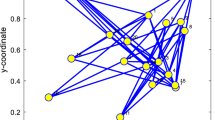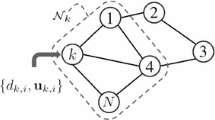Abstract
This paper presents a robust distributed adaptive algorithm called diffusion recursive least M-estimate (DRLM), which enhances the robustness of the diffusion recursive least square (DRLS) algorithm against impulsive noise by incorporating the strong resistance to impulsive noise of the modified Huber function (MHF). However, the tracking speed of the proposed DRLM algorithm is not favorable in scenario where the network parameter vector of interest changes abruptly. To overcome this drawback, a new variable forgetting factor (VFF) strategy is devised and the VFF-DRLM algorithm is obtained. Then, the asymptotic unbiasedness and steady-state network mean square deviation (NMSD) performance of the DRLM algorithm are analyzed. Finally, the accuracy of the steady-state analysis result of the DRLM algorithm and the superiority of the proposed algorithms compared to other competing algorithms are demonstrated by extensive numerical simulations.










Similar content being viewed by others
Data Availability
The data that support the findings of this study are available from the corresponding author on request.
References
R. Abdolee, S. Saur, B. Champagne, A.H. Sayed, Diffusion LMS localization and tracking algorithm for wireless cellular networks, in 2013 IEEE International Conference on Acoustics, Speech and Signal Processing, Vancouver, BC, Canada (2013), pp. 4598–4602
F.S. Cattivelli, C.G. Lopes, A.H. Sayed, Diffusion recursive least-squares for distributed estimation over adaptive networks. IEEE Trans. Signal Process. 56(5), 1865–1877 (2008)
S.-C. Chan, Y.-X. Zou, A recursive least m-estimate algorithm for robust adaptive filtering in impulsive noise: fast algorithm and convergence performance analysis. IEEE Trans. Signal Process. 52(4), 975–991 (2004)
P. Corke, T. Wark, R. Jurdak, W. Hu, P. Valencia, D. Moore, Environmental wireless sensor networks. Proc. IEEE. 98(11), 1903–1917 (2010)
L. Li, H. Zhao, A robust total least mean m-estimate adaptive algorithm for impulsive noise suppression. IEEE Trans. Circuits Syst. II Exp. Briefs. 67(4), 800–804 (2020)
C.G. Lopes, A.H. Sayed, Distributed adaptive incremental strategies: formulation and performance analysis. in 2006 IEEE International Conference on Acoustics Speed and Signal Processing Proceedings, Toulouse, France (2006), pp. III-584-III-587
C.G. Lopes, A.H. Sayed, Diffusion least-mean squares over adaptive networks: formulation and performance analysis. IEEE Trans. Signal Process. 56(7), 3122–3136 (2008)
S. Lv, H. Zhao, Robust multi-task diffusion least mean M-estimate adaptive algorithm and its performance analysis. IEEE Trans. Circuits Syst. II Exp. Briefs 69(4), 2386–2390 (2022)
S. Lv, H. Zhao, L. Zhou, Robust proportionate normalized least mean M-estimate algorithm for block-sparse system identification. IEEE Trans. Circuits Syst. II Exp. Briefs 69(1), 234–238 (2020)
W. Ma, J. Duan, G. Gui, B. Chen, Robust diffusion recursive adaptive filtering algorithm based on lp-norm, in 2016 35th Chinese Control Conference (CCC), Chengdu (2016) pp. 1404–1408.
A. Naeimi Sadigh, H. Zayyani, A proportionate robust diffusion recursive least exponential hyperbolic cosine algorithm for distributed estimation. IEEE Trans. Circuits Syst. II Exp. Briefs. 69(4), 2381–2385 (2022)
A.H. Sayed, Fundamentals of Adaptive Filtering (Wiley, Hoboken, 2003)
S.-Y. Tu, A.H. Sayed, Diffusion strategies outperform consensus strategies for distributed estimation over adaptive networks. IEEE Trans. Signal Process. 60(12), 6217–6234 (2012)
G. Wang, H. Zhao, Robust adaptive least mean M-estimate algorithm for censored regression. IEEE Trans. Syst. Man Cybern. Syst. 52(8), 5165–5174 (2022)
W. Xu, H. Zhao, S. Lv, Robust constrained affine-projection-like adaptive filtering algorithms using the modified huber function. Circuits Syst. II Exp. Briefs IEEE Trans. (2022). https://doi.org/10.1109/TCSII.2022.3218714
Y. Yu, H. Zhao, R.C. de Lamare, Y. Zakharov, L. Lu, Robust distributed diffusion recursive least squares algorithms with side information for adaptive networks. IEEE Trans. Signal Process. 67(6), 1566–1581 (2019)
Y. Yu, H. He, T. Yang, X. Wang, R.C. de Lamare, Diffusion normalized least mean M-estimate algorithms: design and performance analysis. IEEE Trans. Signal Process. 68, 2199–2214 (2020)
H. Zhao, B. Tian, Robust power system forecasting-aided state estimation with generalized maximum mixture correntropy unscented kalman filter. IEEE Trans. Instrum. Meas. 71, 1–10 (2022)
H. Zhao, Y. Chen, S. Lv, Robust diffusion total least mean M-estimate adaptive filtering algorithm and its performance analysis. IEEE Trans. Circuits Syst. II Exp. Briefs. 69(2), 654–658 (2022)
Y. Zhu, H. Zhao, X. He, Z. Shu, B. Chen, Cascaded random fourier filter for robust nonlinear active noise control. IEEE ACM Trans. Audio Speech Lang. Process. 30, 2188–2200 (2022)
Y. Zhu, H. Zhao, X. Zeng, B. Chen, Robust generalized maximum correntropy criterion algorithms for active noise control. IEEE ACM Trans. Audio Speech Lang. Process. 28, 1282–1292 (2020)
Acknowledgements
This work was partially supported by National Natural Science Foundation of China (grant: 62171388, 61871461, 61571374), and Fundamental Research Funds for the Central Universities (Grant: 2682021ZTPY091).
Funding
National Natural Science Foundation of China, 62171388, Haiquan Zhao, 61871461, Haiquan Zhao, 61571374, Haiquan Zhao, Fundamental Research Funds for the Central Universities, 2682021ZTPY091, Haiquan Zhao.
Author information
Authors and Affiliations
Corresponding author
Additional information
Publisher's Note
Springer Nature remains neutral with regard to jurisdictional claims in published maps and institutional affiliations.
Appendix A
Appendix A
1.1 Detailed Derivation of the DRLM Algorithm
Similar to [2], we first update the matrix \({\varvec{P}}_{k,i}\) from \({\varvec{P}}_{k,i - 1}\) by using the rank-1 update, i.e.,
From node \(l = 1\) to \(N\), repeat:
where the matrix \({\varvec{P}}_{k,i}^{l}\) denotes the intermediate result after every rank-1 update. Actually, we need only consider the neighbors of node k, from (A-1) and using the matrix inversion lemma, we can obtain
For node \(l \in {\mathcal{N}}_{k}\), repeat:
Next, we define the matrices \({\mathbf{\mathcal{D}}}_{i}^{l}\), \({\mathbf{\mathcal{U}}}_{i}^{l}\), \({\mathbf{\mathcal{W}}}_{k,i}^{l}\) and \({\mathbf{\mathcal{Q}}}_{i}^{l}\) as follows:
Then, the intermediate estimate vector can be given by
where
Since we have \(\user2{\varphi }_{k,i - 1} = \user2{\varphi }_{k,i - 1}^{N} \triangleq \user2{\varphi }_{k,i}^{0}\), the \(\user2{\varphi }_{k,i}\) can be updated recursively from \(\user2{\varphi }_{k,i - 1}\) by instead updating \(\user2{\varphi }_{k,i}^{N}\) recursively from \(\user2{\varphi }_{k,i}^{0}\). Assuming that \(j\) is the minimum index satisfying \(c_{j,k} \ne 0\), \(\user2{\varphi }_{k,i}^{j}\) can be deduced from \(\user2{\varphi }_{k,i}^{0}\) as follows
where
and
Similarly, \(\user2{\varphi }_{k,i}^{l}\) can be updated from \(\user2{\varphi }_{k,i}^{l - 1}\) recursively, for \(l > j\), repeat:
In ight of (A-2), (A-5) and (A-7), we can summary the increment update process as follows
for \(l = 1\) to \(N\), repeat
Finally, the above obtained intermediate weight vectors are weighted and combined, and the weight vector \({\varvec{w}}_{k,i}\) is given by
Rights and permissions
Springer Nature or its licensor (e.g. a society or other partner) holds exclusive rights to this article under a publishing agreement with the author(s) or other rightsholder(s); author self-archiving of the accepted manuscript version of this article is solely governed by the terms of such publishing agreement and applicable law.
About this article
Cite this article
Lv, S., Zhao, H. Robust Diffusion Recursive Least M-Estimate Adaptive Filtering and Its Performance Analysis. Circuits Syst Signal Process 42, 4929–4952 (2023). https://doi.org/10.1007/s00034-023-02343-0
Received:
Revised:
Accepted:
Published:
Issue Date:
DOI: https://doi.org/10.1007/s00034-023-02343-0




